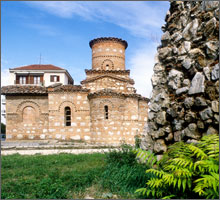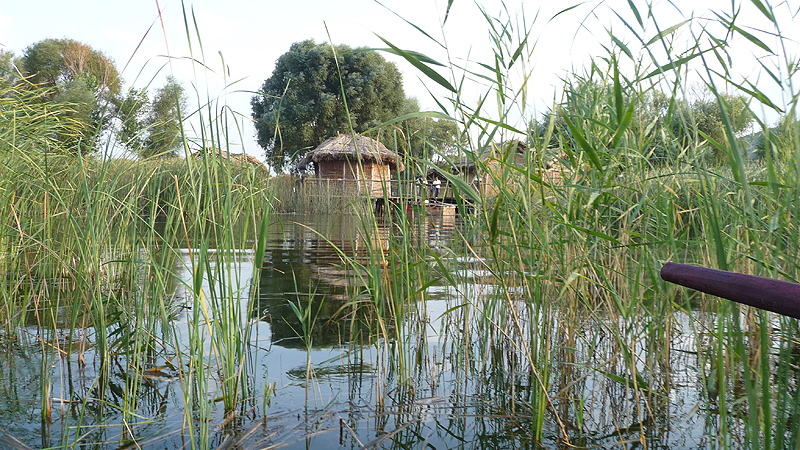Picture: http://www.mpetskas.gr
You will fall in love with the place as soon as you exit the turns among the hills. This city by the lake is different.
This is one of the most beautiful cities of Greece. And this beauty is due to many factors. Firstly, the city of Kastoria is built on the "throat" of a peninsula that reaches Lake Orestiada at an altitude of 620 metres. Other factors include the 74 churches and approximately 140 large houses - all of which are architectural masterpieces dating back to the 17th and 18th century and built of stone and wood. Nature, sights of the area and, of course, the vivid city and its nightlife add to all this.
According to mythology, Kastoria was named after Zeus’s son - Kastoras. It is also possible that the name came from the Bulgarian word “Kostour”, meaning fortress. The history of the city is rich. According to Roman historian Livy, in the 5th century BC there was a town called Keletron at the place where the city lies today, and in the 6th century AD Procopius mentioned the name of Kastoria for the first time as a lake’s name.
During the Byzantine period, the natural beauty of the place attracted the interest of emperors. Originally, the town was fortified by Diocletian who built a new city - Diocletianopolis. In 550, Justinian turned the city into the strongest fortress with reinforced walls in order to withstand Slavic invasions and renamed it to Justinianopolis. After the fall of the Byzantine Empire, the town was conquered by the Turks and was liberated in 1912.
Today it is a modern city with 20,000 inhabitants and numerous inscriptions in Cyrillic. Here, Russians are the best customers of local furriers.
A few years ago, Kastoria was a very wealthy city and its residents had the highest income per capita in the world. Wealth came from furs and artisans known since Byzantine times. Here, 30% of world production is produced, which is sent to international markets and nearly all inhabitants were engaged in fur. Today, fur trade is going through a crisis and townspeople are engaged in tourism.

The first apartment block was built in 1972. Despite all the wealth, people obvious like living in a box. At least the blocks are tiled and somehow save the situation with regard to aesthetics. The locals are very hospitable to visitors, while, at the same time, they are strong competitors among themselves.
What to see...

The Monastery of Panagia Mavriotissa – at the end of the peninsula, built in the era of Alexios I Komnenos (1081 to 1118). The special location of the town endows it with two coasts – a northern and a southern coast. A coastal road covered with sycamore trees starts from the south beach and goes round the entire peninsula. Every visitor must take this trip by car. You will also find the monastery there. Be sure to see the wall-paintings and light a candle. This trip will take you to a lake full of fish and you will see dozens of fishermen with their rods. You can try various types of fish.
Doltso - in the middle of the south coast, there is a square covered with stones - Doltso Square, where the centre of the city's famous Carnival is located - Ragoutsariya. This is a three-day carnival, which begins on Epiphany; its peak is on 7 January and the carnival ends on 8 January. Its name and its origins lie in Roman times. Near the square you will see a lot of old houses and two of them – Nadzi’s and Emmanuel’s - can be visited if they are open.
The acropolis of the Byzantine fortress of Kastoria - very close to the walls and the two towers, you can find one of the most important Byzantine monuments in Macedonia - Panagia Koubelidiki, as known today. The name “koubelidiki” was attributed during the years of the Turkish occupation. “Koubes” in Turkish means “dome”. This is the only domed church in Kastoria. Its Byzantine name was probably Panagia Skoutariotisa and Akatamahitos (unbeatable) - in honour of the Virgin Mary as the protector of the walls.
The Byzantine and the Ethnographic museums - they are particularly rich.
Trips outside the city

Some 7 kilometres away from Kastoria, on the road to Kozani, you will find the lake settlement of Dispilio. It is located on the southern shore of the lake and was accidentally discovered in 1932. This is the first lake settlement excavated in Greece. Since 1992, excavations have revealed important findings that show that, 7,000 years ago, prehistoric people living in the area knew how to fish, hunt and work the land with advanced tools for the era. Also, they wrote signs on wood in order to communicate. While this writing is still unreadable, its age (dating back to 5,300 BCE) shows that it preceded Linear A. There is an exact reconstruction of the lake settlement on the bank of the lake with huts that have been built on pile platforms.
27 km from Kastoria, after Argos Orestiko, you can find the Fossilised Forest of Nostimo aged 20 million years. The findings are many and unique. There was a prehistoric sea that irrigated the area; you can see a tooth of a prehistoric shark, as well as fossilised oysters, sea urchins and shells. Besides marine animals, plants that grow in tropical and subtropical climates were also discovered. The most important plant discoveries include the petrified palm trees that have not been discovered anywhere else in mainland Greece. You will also see elephant teeth aged 3.5 million years. All findings are kept in the school. There are always guards, but it is best to call before you go (phone: 24670-84588).
You can also take a nice walk in the abandoned village of Mavrokampos. The houses there are made of bricks, and the roofs are covered with tiles.
Those who enjoy sports activities will love the ski centre of Vitsiou. Located 27 km on the road to Visinia-Oksia-Vitsiou, you will find Vitsiou winter resort at an altitude of 1,610 m (phone: 24670-24884). The ski centre has 3 lifts and 5 slopes. The central slope is 1,000 m long, the side north-eastern one is 2,500 m long and the side north-western one is 1,300 m long. If you get tired, a coffee bar and a restaurant also operate at the ski centre.
Very close to the city, just 8 km away, you can find the village of Koromilia. If you park your car at its end, you can take a walk through the gorge of Koromilia.
Nestorio is located 28 km away. There, the River Party festival is organised annually featuring artists from across the country and many visitors. At the foot of Grammos you can see the mouth of Aliakmonas.
If you have special interests
The School for manufacture and study of traditional musical instruments – this is the only such school in Europe and probably the only one in the world, too. It was established two years ago and accepts 5-6 students per year. They study for four years and Yiannis Koukouringos is the school’s principal.
How to get there
By plane - from Athens, the airport is located in Argos Orestiko
By car - 510 km from Athens and 210 km from Thessaloniki.
Where to stay
Hotel Vergoula – an old restored house, overlooking the lake, phone: 24670-23415
Hotel Kastoria - above the lake, at the beginning of the north beach, phone: 24670-29453
Chloe Hotel- located in the area of Chloe, phone: 24670-21300